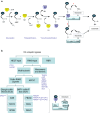Manifold role of ubiquitin in Helicobacter pylori infection and gastric cancer
- PMID: 33825941
- PMCID: PMC8195768
- DOI: 10.1007/s00018-021-03816-8
Manifold role of ubiquitin in Helicobacter pylori infection and gastric cancer
Abstract
Infection with H. pylori induces a strong host cellular response represented by induction of a set of molecular signaling pathways, expression of proinflammatory cytokines and changes in proliferation. Chronic infection and inflammation accompanied by secretory dysfunction can result in the development of gastric metaplasia and gastric cancer. Currently, it has been determined that the regulation of many cellular processes involves ubiquitinylation of molecular effectors. The binding of ubiquitin allows the substrate to undergo a change in function, to interact within multimolecular signaling complexes and/or to be degraded. Dysregulation of the ubiquitinylation machinery contributes to several pathologies, including cancer. It is not understood in detail how H. pylori impacts the ubiquitinylation of host substrate proteins. The aim of this review is to summarize the existing literature in this field, with an emphasis on the role of E3 ubiquitin ligases in host cell homeodynamics, gastric pathophysiology and gastric cancer.
Keywords: Bacteria; Cancer; E3 ubiquitin ligases; Inflammation; MDM2; NF-κB; T4SS; p53; β-catenin.
Conflict of interest statement
The authors declare that they have no conflict of interest.
Figures



Similar articles
-
Helicobacter pylori pathogen regulates p14ARF tumor suppressor and autophagy in gastric epithelial cells.Oncogene. 2018 Sep;37(37):5054-5065. doi: 10.1038/s41388-018-0343-8. Epub 2018 May 30. Oncogene. 2018. PMID: 29849123 Free PMC article.
-
Loss of TFF1 promotes Helicobacter pylori-induced β-catenin activation and gastric tumorigenesis.Oncotarget. 2015 Jul 20;6(20):17911-22. doi: 10.18632/oncotarget.3772. Oncotarget. 2015. PMID: 25980439 Free PMC article.
-
Caudal type homeoboxes as a driving force in Helicobacter pylori infection-induced gastric intestinal metaplasia.Gut Microbes. 2020 Nov 9;12(1):1-12. doi: 10.1080/19490976.2020.1809331. Gut Microbes. 2020. PMID: 33031021 Free PMC article.
-
Helicobacter pylori and interleukin-8 in gastric cancer.World J Gastroenterol. 2013 Dec 7;19(45):8192-202. doi: 10.3748/wjg.v19.i45.8192. World J Gastroenterol. 2013. PMID: 24363509 Free PMC article. Review.
-
Helicobacter pylori-induced gastric inflammation and gastric cancer.Cancer Lett. 2014 Apr 10;345(2):196-202. doi: 10.1016/j.canlet.2013.08.016. Epub 2013 Aug 24. Cancer Lett. 2014. PMID: 23981572 Review.
Cited by
-
Comprehensive characterization of ubiquitinome of human colorectal cancer and identification of potential survival-related ubiquitination.J Transl Med. 2022 Oct 2;20(1):445. doi: 10.1186/s12967-022-03645-8. J Transl Med. 2022. PMID: 36184622 Free PMC article.
-
[Nur77 promotes invasion and migration of gastric cancer cells through the NF-κB/IL-6 pathway].Nan Fang Yi Ke Da Xue Xue Bao. 2022 Sep 20;42(9):1410-1417. doi: 10.12122/j.issn.1673-4254.2022.09.19. Nan Fang Yi Ke Da Xue Xue Bao. 2022. PMID: 36210716 Free PMC article. Chinese.
-
Brucella suis S2 strain inhibits IRE1/caspase-12/caspase-3 pathway-mediated apoptosis of microglia HMC3 by affecting the ubiquitination of CALR.mSphere. 2025 Mar 25;10(3):e0094124. doi: 10.1128/msphere.00941-24. Epub 2025 Feb 28. mSphere. 2025. PMID: 40019270 Free PMC article.
-
Potential contribution of Helicobacter pylori proteins in the pathogenesis of type 1 gastric neuroendocrine tumor and urticaria. In silico approach.PLoS One. 2023 Apr 25;18(4):e0281485. doi: 10.1371/journal.pone.0281485. eCollection 2023. PLoS One. 2023. PMID: 37098080 Free PMC article.
-
Implication of protein post translational modifications in gastric cancer.Front Cell Dev Biol. 2025 Feb 4;13:1523958. doi: 10.3389/fcell.2025.1523958. eCollection 2025. Front Cell Dev Biol. 2025. PMID: 39968176 Free PMC article. Review.
References
Publication types
MeSH terms
Substances
Grants and funding
LinkOut - more resources
Full Text Sources
Other Literature Sources
Medical
Research Materials
Miscellaneous

